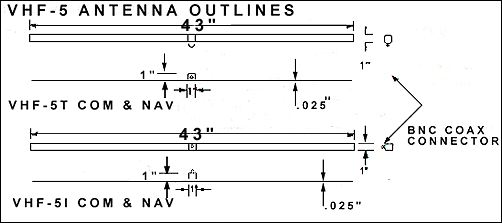(one time tooling charges will be added to the cost)
The VHF antennas, 5T and 5I, differ only in the location of the BNC connection. The 5T is configured to allow the coax cable to be routed flat along the mounting surface of the airframe. This antenna model would be appropriate for a composite aircraft where the antenna would be mounted in the fuselage or fin and the coax would be close to the skin and be attached periodically for strain relief. In either case, the antenna can be used as a retrofit on in service aircraft or in new installations.
The 5I series has the BNC connection positioned so that the coax cable would route out and away from the antenna mounting surface. This configuration is offered for antenna installations such as wing tips of fabric aircraft. If the antenna is mounted on the inside of the tip, the coax route is directly inward toward the wing root and the BNC connection is located near the spar to provide support for the cable.
Both antennas are identical in their electrical performance.
Fabric airframes can use this antenna in either the fuselage or the wing. Silver dope is not a problem with this antenna, however, attention must be given to the attachment of the antenna to the airframe to optimize performance. In a wing installation, attachment to a wooden rib or wooden spar is a must. In the fuselage, behind the seats in the tail cone is best. Here it is best to keep the antenna away from the metal structure.
For those builders who want to permanently build the antenna into their aircraft in difficult to reach locations, we offer any of the models without the BNC connector but with a length of coax cable manufactured with the antenna. We do this to eliminate the possibility of connector degradation over the lifetime of the aircraft. The cost for this special option is 50 cents per foot of coax using the light weight RG174/U or the standard RG58/U. These assemblies are custom manufactured and cannot be delivered from stock. Call for delivery times.
